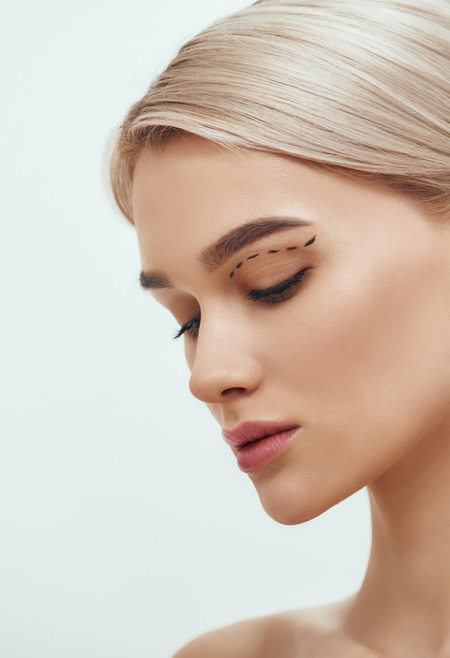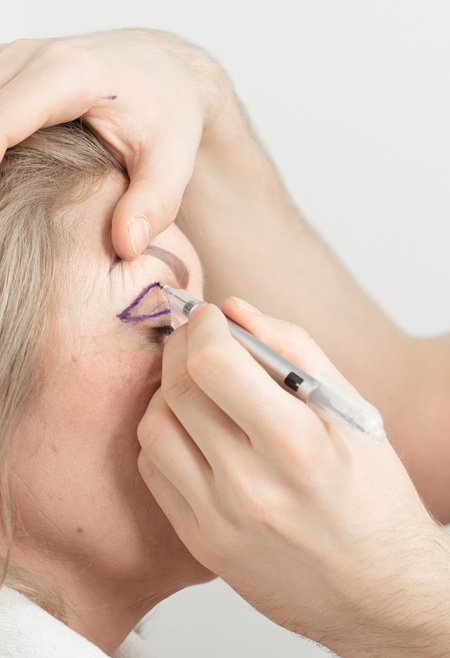Call Us - +(90) 546 776 9042
Heavy and redundant eyelid skin can conceal the contours of the upper and lower eyelid, making the eyes and whole face appear tired. Eyelid Surgery removes the excess skin and skin folds and tightens the eyelid skin to produce a dramatically younger and more awake eye appearance.

What is eyelid aesthetics?
It is a surgical operation intended to treat the sagged and wrinkled upper eyelid and loosened and bagged lower eyelid due to ageing and gravity.
during this operation, the excessive skin on the upper lid is removed, the looseness of the lower eyelid is fixed and the fat tissues referred to as “bags” are reshaped. Consequently; patients are relieved from their tired and sleepless appearance and they gain a fresher and lively look.
Who undergoes eyelid operation?
This operation is usually performed on patients over the age of thirty, with excessive skin on their upper eyelids and/or bags under their eyes.


What should be done prior to surgery?
As in all plastic surgeries, the patient should quit smoking minimum two weeks prior to the operation and should also avoid smoking for two weeks after the operation. Anticoagulant drugs, such as Aspirin etc. should be quitted minimum 10 days before the operation. The patient should discontinue any other medication or dietary supplement (medication that include Ginseng, CoQ, Gingko Bloba etc.) 1 week before the surgery. The patient should also disclose any other significant condition to their surgeon.
What is the surgery technique?
The incision on the upper eyelid is applied in line with the eyelid curve, and the one on the lower eyelid is applied just below the eyelashes or sometimes inside the eyelids. Excessive skin is removed, fat tissues are reshaped and the area between the eyelid and cheek is smoothened. The operation usually takes 45 minutes to 1 hour on average.
What to expect after the eyelid surgery
Patients can be released from the hospital on the operation day or they might be hospitalized for 1 night. There might be slight bruising and swelling around the eyes. Sutures are usually removed between the 5th-7th days. Bruising and swelling should be gone after 1 week and patients can resume their works then.
All-Inclusive Individual Package
Price includes surgery, medication, support bra, 1 or 2 nights hospital stay, 5 or 6 nights hotel stay, VIP transfers and an English speaking host.
On the morning of your procedure, you will be picked up by your patient coordinator and transferred to the hospital where you will have a consultation your surgeon. He will assess your chest wall to determine the right implant shape and size for you. Afterwards, you will have medical tests to check your suitability for surgery and once confirmed the procedure will last around 1-2 hours. You will spend the night at the hospital following your surgery.– Day 1
You will be discharged from the hospital in the morning following a check-up by your surgeon. You will be transferred to your hotel where you will continue to rest.– Day 2
You are advised to continue resting, but once you start feeling better you can go out to explore the city on days 5 and 6.– Days 3, 4, 5 & 6
On your last day, you will have a final check-up by your surgeon and you will be ready to go home after receiving instructions on postoperative care. Stitches do not need to be removed as they will dissolve by themselves.– Day 7
Procedure Time
The operation usually takes 45 minutes to 1 hour on average.
Anaesthetic
Surgeries are carried out under general anaesthesia in a general hospital.
Recovery
The patient can return to work after 1 week.
Frequently Asked Questions
What type of anesthesia is used during eyelid surgery?
Dr. Ceber performs eyelid surgery using either local anesthesia or general anesthesia under the supervision of a board-certified anesthesiologist to ensure patient comfort and safety.
Am i the riggt candidate for eyelid surgery?
An ideal candidate for eyelid lift surgery requires:
- A full understanding of the benefits and limitations of eyelid surgery
- The ability to take time off from work and limit certain activities during the recovery period
- A willingness to closely follow all of Dr. Ceber’s pre-operative and post-operative instructions
It is important to discuss your medical history with Dr. Ceber in great detail.
When will i see the final results of my eyelid surgery?
Eyelid surgery results will become fully noticeable within four to six weeks. Residual inflammation and bruising will subside within the first month. However, the eyelid area may have slight swelling for several months. Once you are completely healed, the eyelids will appear more youthful, lively, and defined.
What results can I expect from post-bariatric surgery?
Most patients are thrilled with the outcome of their post-bariatric procedure. They can enjoy improved mobility, smoother body contours, and a more youthful figure. Scars may develop along the incision locations, but they will likely fade over time, and our surgeons are careful to place them in areas that are easily concealed with clothing.

